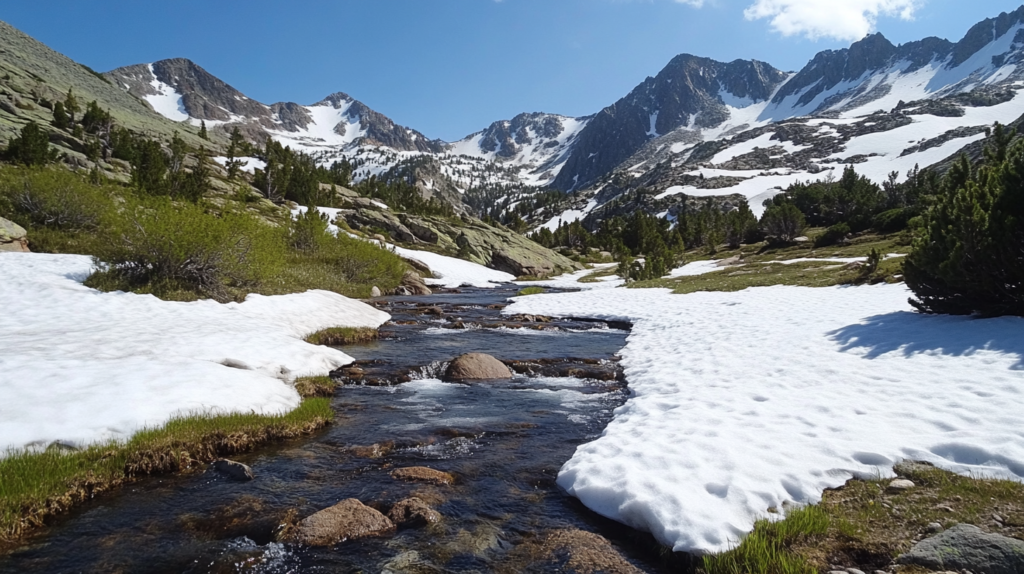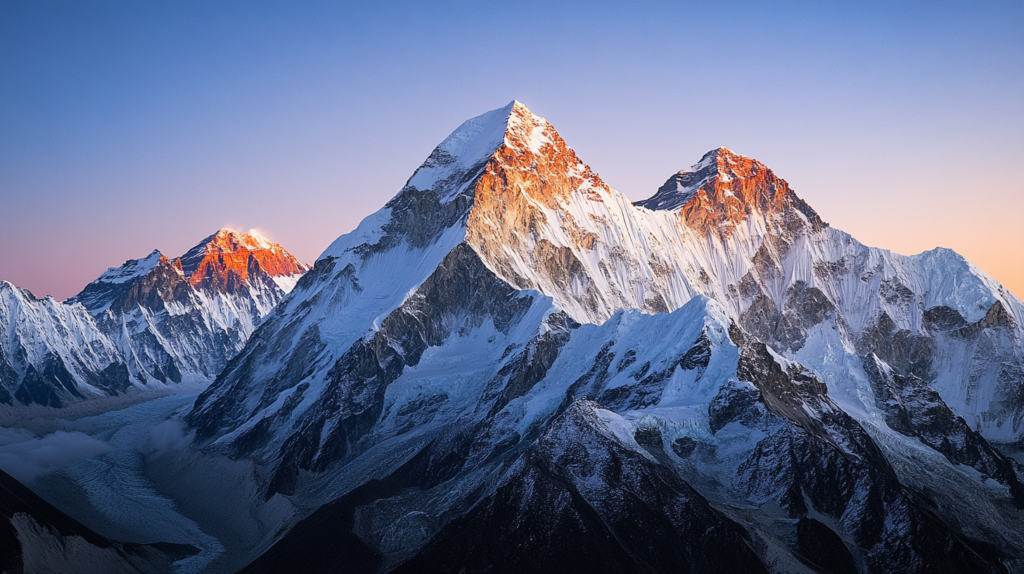
Artificial Intelligence – Part III
[Editor’s Note: This article is the third in a series chronicling the potential for artificial intelligence to craft this project. Each year, we ask ChatGPT to write an issue on mountains and provide the imagery with Midjourney. Everything that follows is unedited and not crafted by humans (other than the fact that large language models, the basis for current AI, comes from previously written human material).
To see the progression of the series, point your browswer to Part I and Part II.]

The Majestic Mountains: Architecture of the Earth’s Landscape
by ChatGPT
Mountains are among the most awe-inspiring features of our planet, standing as silent sentinels that guard entire continents. Rising dramatically from plains and plateaus, they loom large not only in a physical sense but also in the cultural, spiritual, and emotional landscapes of human life. From the soaring peaks of the Himalayas to the rugged ranges of the Andes, from the Alps in Europe to the Rockies in North America, these natural monuments shape climates, influence biodiversity, and inspire countless generations of explorers, artists, and thinkers. Understanding mountains is not merely about appreciating their grandeur; it’s also about learning the profound influences they have on our world and ourselves.
Formation and Geology of Mountains
Mountains form through a dynamic interplay of immense geological forces. At the heart of mountain building lies the concept of plate tectonics: the idea that the Earth’s crust is composed of interlocking plates that move very slowly, often crashing into or sliding beneath one another. When continental plates collide, the Earth’s crust can buckle and fold, pushing up ranges of staggering scale. This process is most famously embodied in the Himalayas, where the Indian Plate converges with the Eurasian Plate, creating some of the world’s tallest peaks—Mount Everest and K2 among them. Other mountain chains, such as the Andes, result from oceanic plates subducting beneath continental crust, which also leads to volcanic activity and the formation of mighty volcanic summits.
Over millions of years, these tectonic collisions raise entire swaths of land high above sea level. But mountains are not static; they are continuously shaped and sculpted by the relentless forces of weathering and erosion. Water, ice, and wind gradually chip away at their faces, carving valleys, exposing unique rock strata, and smoothing or sharpening their outlines. Earth’s mountains are thus both ancient geological tapestries and works-in-progress—constantly evolving, eroding, and emerging in an endless cycle that links Earth’s past to its future.

Climate and Weather Patterns
Mountains play a pivotal role in shaping regional and global climates. Their towering heights act as natural barriers that force moist air upward, leading to cooling and condensation, and often resulting in significant rainfall or snowfall on their windward slopes. Meanwhile, the leeward side—the side sheltered from prevailing winds—tends to be drier, often hosting arid or semi-arid conditions. The differences in temperature, precipitation, and sunlight at varying elevations create distinct microclimates, allowing a single mountain range to offer a mosaic of environments—from lush, temperate forests in the foothills to alpine meadows, tundra-like conditions near the summits, and glaciers topping their highest peaks.
In addition, mountains influence large-scale weather systems. They can redirect storm tracks, alter wind patterns, and even play a role in the distribution of snow and ice that feeds some of the world’s great rivers. Many major waterways—such as the Ganges, Yangtze, and Colorado—originate in mountain regions, carrying life-giving waters to downstream communities and agricultural lands. Without mountains, the world’s rainfall patterns, freshwater availability, and climate stability would look drastically different.
Biodiversity and Ecosystems
The varied topography of mountains fosters an astonishing breadth of life. From the base to the summit, as elevation increases, the conditions become progressively harsher, with thinner air, colder temperatures, and more intense solar radiation. Plants and animals have developed remarkable adaptations to these challenges. In lower elevations, thick forests abound, sheltering a variety of tree species, birds, and mammals. As one ascends, these forests give way to alpine meadows filled with hardy grasses and wildflowers that bloom in vivid colors during the short, cool summers. Higher still, only the most resilient life forms—mosses, lichens, and a few specialized insects—manage to cling to existence.
This vertical layering of habitats, known as altitudinal zonation, means that within a single mountain, you might encounter ecological conditions that resemble multiple latitudes compressed into one steep gradient. As a result, mountain regions often boast high levels of endemism—species found nowhere else on Earth. The isolation created by steep slopes and deep valleys can lead to evolutionary uniqueness, contributing to global biodiversity. Mountains serve as refuges for species threatened by changes in the climate and are crucial genetic reservoirs that humanity may rely on in the future as environmental conditions shift.

Cultural and Historical Significance
Mountains have long held a special place in the human psyche. They have been seen as the homes of gods, the realms of spirits, and the ultimate tests of courage and perseverance. Countless myths and religious traditions revolve around sacred peaks. Mount Olympus in Greece was believed to be the abode of the gods in ancient mythology, while Mount Kailash in the Himalayas is revered by Hindus, Buddhists, and other faiths, symbolizing cosmic centers and divine power.
Historically, mountains have also served as natural fortresses and borders, providing protection or acting as barriers to invasions. They have influenced human settlement patterns, often giving rise to isolated cultures that develop their own languages, customs, and traditions. In places like the Andes and Himalayas, indigenous communities have adapted to high-altitude life over generations, developing agricultural practices suited to steep slopes and thin air. Today, these highlands are repositories of cultural wisdom, from terrace farming techniques to herbal medicinal knowledge, passed down through centuries of observation and experience.
Recreation, Exploration, and Tourism
The allure of mountains extends beyond their spiritual and cultural significance. Adventurers and nature enthusiasts are drawn to these high places for recreation and exploration. Mountaineering, rock climbing, trekking, skiing, and snowboarding are just some of the activities that beckon those who seek challenge, solitude, and inspiration. The mountaineer’s quest to stand on top of the world’s highest summits, risking life and limb in pursuit of a lofty goal, has produced legendary tales of triumph, tragedy, and human endurance.
Tourism in mountain regions has grown significantly in modern times, bringing both benefits and concerns. On one hand, it provides income to local communities and encourages cultural exchange. On the other, increased foot traffic can place stress on fragile ecosystems, contribute to pollution, and alter the natural balance that has been maintained for millennia. Sustainable tourism practices aim to minimize these impacts, ensuring that future generations can continue to experience the thrill and magnificence of mountainous landscapes.

Environmental Threats and Conservation
Despite their durability and grandeur, mountains are not immune to environmental threats. Climate change is perhaps the most urgent challenge they face. As global temperatures rise, glaciers—vital freshwater reservoirs—are melting at unprecedented rates. Shifting precipitation patterns can lead to altered river flows, droughts, and more frequent landslides, impacting downstream communities and ecosystems.
Biodiversity loss is another concern. Species that have adapted to narrow elevation ranges find it difficult to move as the climate warms, potentially facing extinction if their habitats disappear. Human activities—such as mining, deforestation, and overdevelopment—can degrade these environments, disrupt wildlife corridors, and undermine the cultural integrity of indigenous communities who have lived harmoniously with the mountains for centuries.
Conservation efforts aim to balance the needs of people and nature. Protected areas, national parks, and UNESCO World Heritage Sites help safeguard critical mountain environments. Community-led initiatives ensure that local voices guide decisions about resource use. Scientific research, environmental education, and international cooperation are essential tools for preserving the integrity of mountain ecosystems and cultural heritage. By valuing mountains not just for their scenic beauty but for their life-sustaining functions, we can work toward a more sustainable, harmonious relationship with these environments.

A Symbol of Endurance and Inspiration
Mountains stand as powerful symbols of what the Earth can create, of what time and tectonic forces can shape out of rock and soil. They remind us of the immense scales of geological time—of epochs that dwarf the human lifespan—and invite us to consider our place in the grand narrative of the planet. They have inspired poets, philosophers, and painters to capture their mystique, encouraging humanity to reach for higher ideals and broader perspectives.
In a world that is increasingly interconnected and digital, mountains offer a tangible connection to nature’s rawness and resilience. They teach patience, perseverance, and respect for forces beyond our control. They challenge us to scale our own inner heights, to overcome our limitations, and to nurture awe and gratitude for the planet that sustains us.
In the end, mountains are not just landforms; they are living chapters in Earth’s story. Their peaks and valleys hold clues to past climates, to the evolution of life, and to the cultural journeys of countless human societies. By cherishing and protecting these towering landscapes, we acknowledge their role in our shared future—one that depends on the delicate interplay of human ambition, environmental stewardship, and the timeless majesty of the mountains themselves.
Further Reading and Exploration
OpenAI – Official Website
ChatGPT – Official Website
Midjourney – Official Website
2022 Experiment – The Mountains Are Calling
2023 Experiment – The Mountains Are Calling













